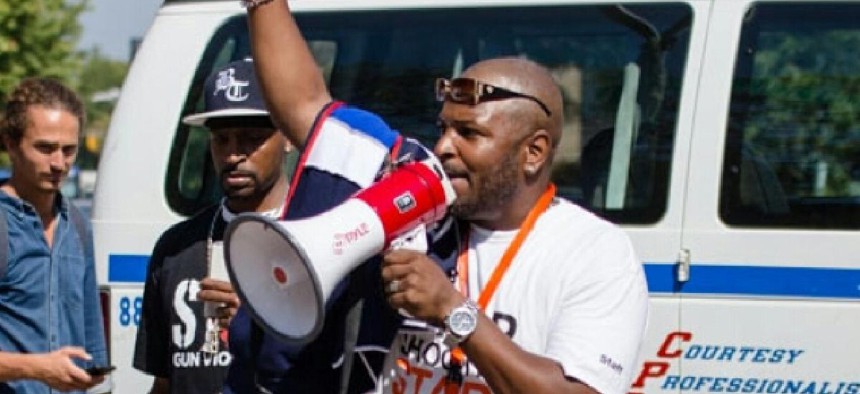Front-Line Hero: Curing violence with Derick Scott

When asked to sum up his high school experience during a job interview, Derick Scott didn’t quite offer a textbook response: “High school, wow: Sex, drugs and rock and roll.”
Run-ins with gangs, fights as well as knife and gun violence rounded out Scott’s description of his younger years – along with “living through it all.” His experiences perfectly qualified him to direct a New York City Cure Violence program known as Operation Helping Our Own Develop – the nonprofit Jewish Community Council of Greater Coney Island’s newest initiative.

Scott is also a staff trainer for the New York City Cure Violence project under the Health Department's Center for Health Equity. But in the 80s, on the streets of Brownsville and West Brighton, “They called me Justice,” Scott said.
“Justice is a reward or penalty for his or her ways or actions,” he said. “That was my name.”
Since 2010, Scott has been on the front lines of bringing the Cure Violence model, piloted in Chicago, into communities that, for too long, have experienced arguments and tensions becoming deadly confrontations. Infectious disease specialist Dr. Gary Slutkin helped develop the approach from public health strategies in which gun violence is treated like a disease and outbreaks are aggressively attacked at their source to prevent their spread. Scott is what the model calls a credible messenger: one who can speak from personal experience to individuals entrenched in a potentially violent conflict – and command their respect.
“He’s got a big brother vibe – he’s got a aura of compassion around him, when you see him move, when you hear him speak, you always feel like it’s like a common thread of sincerity around how he approaches you,” said K. Bain, founding program director of 696 Build Queensbridge, which is modeled after Cure Violence and recently celebrated a record 365 days without a shooting at the public housing project.
Bain met Scott while Scott was working with the Save Our Streets program, which operates with support from the Center for Court Innovation and the Crown Heights Community Mediation Center. The program was the first to iterate the Cure Violence model in New York City and Scott was their first hire.
And the program showed promise. There was a 20 percent lower shooting rate in the program’s part of Brooklyn’s Crown Heights neighborhood, according to a report from the Center for Court Innovation from January 2010 through May 2012.
In October 2016, Operation HOOD celebrated 200 gunfire-free days in Coney Island.
Today, there are 18 sites across the city that have similar programs modeled after Cure Violence, with a workforce of about 150 people. Outreach workers are tasked with interrupting conflicts, helping to change behaviors and staging responses to shootings to make the point that gun violence is unacceptable in the neighborhood. They also provide additional support services, where possible, to the victims, families or individuals involved.
“Had we done ill will, or had we done wrong, or had we not had our model proven and tested, there wouldn’t be 18 sites in New York City today,” Scott said.
When a conversation got heated, Scott would always remove the one with the “biggest mouth” and try to calm them down, said Rudy Suggs, one of Save Our Streets’ first violence interrupters. Scott would say things like, “After you shoot this person then what? What happens to that person’s family?” Suggs said. “That person no longer has a son, a father, a husband or a brother. Guess what happens to you – you’re going to jail for 25 years. You’re holding your family hostage for the next 25 years.”
Scott doesn’t use it as a badge of honor, but says his prison stint helped him find freedom. He studied Islam and learned to speak Arabic, which helps him build relationships with local shop owners and religious and community leaders. When networks are strong, violence interrupters hear about altercations and rising tensions even before local police.
Scott has also worked with the program as a hospital responder.
“That’s the front line of all front lines going right there in the hospital when a person gets shot or when a person gets stabbed. We’re right there on the front lines trying to establish certain things, trying to stop a retaliation from happening,” Scott said.
And retaliation can happen sometimes just to help the victim save face. “The streets is watching so they can’t keep focused,” Scott said. “They too involved in what the people may think of them, instead of what they think of themselves.”
Scott has seen many shooting victims. He’s been to the funerals of young people he was counseling and lost a brother to gun violence. He says he doesn’t fear anything anymore.
“I know that I’m not the perfect man, far from it,” Scott said. “I built myself to this person today but I wasn’t always this person. I was angry, I was very withdrawn. I was that person that would fight at the drop of a dime … I used to play with guns, I used to do a lot of things that these kids today seen in movies. I know these things already.”
“I channel my fear into more doing what’s right.”